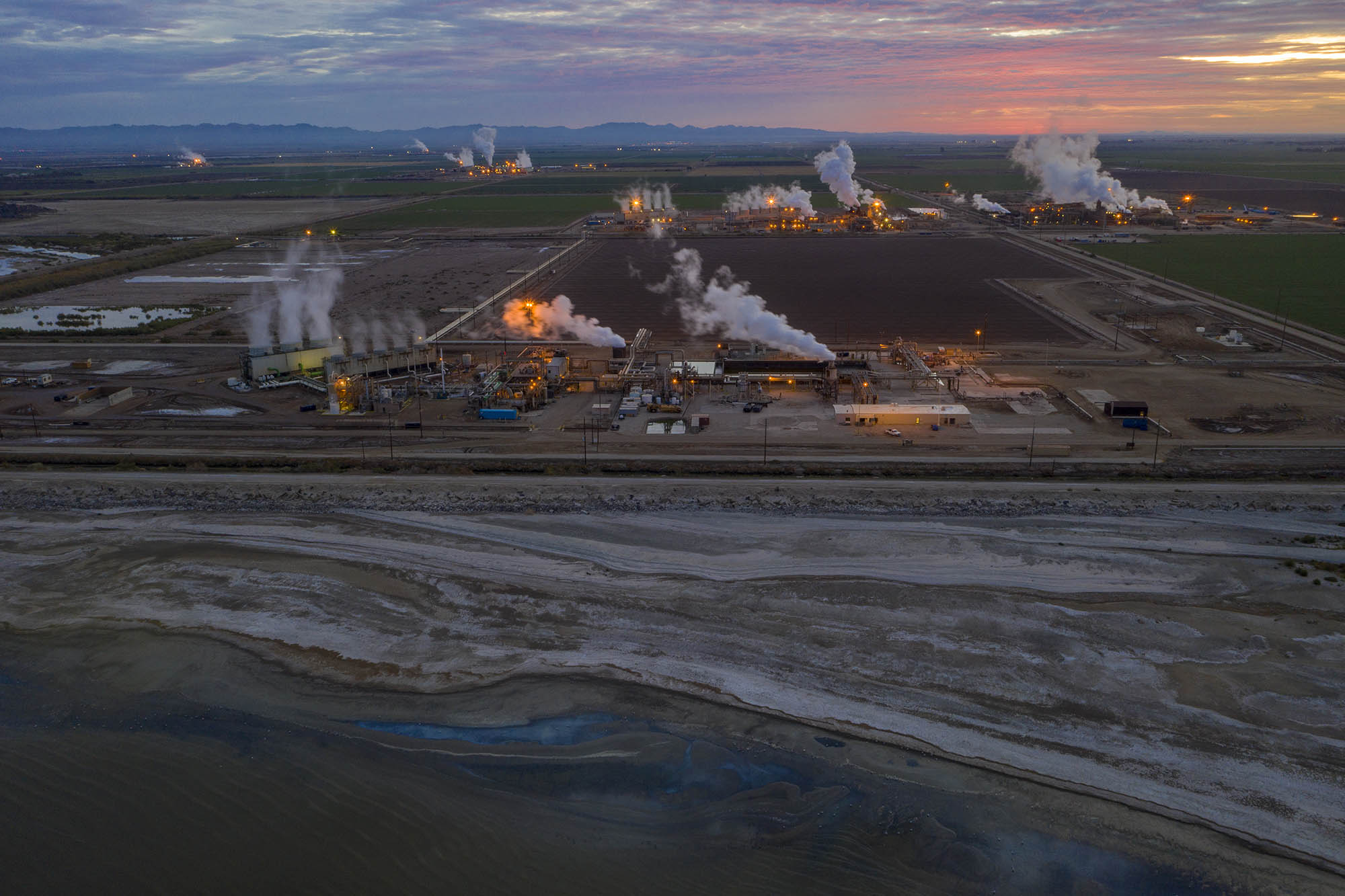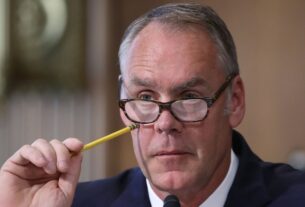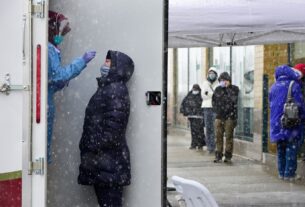The hunt for lithium and environmental justice on the shores of a dying lake

tanding on the banks of the lakeshore, Darlene Berber’s view of her former neighbourhood was both familiar and strangely altered.
“That’s where the marina used to be,” she said, as she guided us round what remains of Vista Del Mar. “There was a bar and they had a patio and had like a little snack shop, and stuff like that. The kids were ordering hotdogs and there were people on ATVs [All Terrain Vehicles] with just a lot going on.”
But the waters of the Salton Sea, California’s largest lake, are receding every year and now all that remains of this community are empty stretches of bleached out sand, crumbling foundations, graffitied homes and memories. As she treks with crunching steps across the exposed lakebed, made up now more of dead barnacle shells and fish skeletons than sand, Darlene is prone to reminisce about the promise the area once held, rather than the one it currently faces.
“It’s dire,” she said. “Why, when you have such a great thing, why would you let it die?”
The Salton Sea was a tourist hotspot between the 1930s and ’50s. Lured to the “miracle in the desert”, families visited the lake and the area around it to get away from the daily realities in nearby Los Angeles and plunge into the blue lake, or fish for the abundant stocks of firm-fleshed corvina that tasted so great on the grill.
Created by accident in 1905 when a levee in the desert broke, letting water from the Colorado River flow into the low-lying basin for two years, the Salton Sea was never supposed to be there. But entrepreneurs hoping to build the next Palm Springs embraced it. In its prime it pulled in 1.5 million people every year – more visitors than Yosemite National Park. You can still see sun-faded signs welcoming swimmers. People sent postcards home from places like “North Shore Beach: The Glamour Capital of Salton Sea.”
But late in the last century, things started to change. Cut off from its source, the only water coming into the sea was from toxic runoff from nearby farms growing crops such as watermelon, capsicum and avocados.
The water became so salty that on one hot summer’s day in 1999, 7.8 million fish died in one day. Birds began dying too. By that time, the lake was already shrinking nearly a football field a year, exposing dust laced with pesticides. When the wind picked up it blew the dust – and the residual smell of decaying fish – into the surrounding communities.
What stands today is a place of bleached out ruins under a blistering desert sun, where a slow-moving environmental disaster continues to unfold with little mitigation.
Los Angeles is only a three-hour drive away, and 25 miles up the road, the Coachella music festival takes place, the closest thing in the US to Glastonbury. But, none of that glamour and money makes its way down here.
Today, the typical visitors to the region are Instagrammers and Tik Tokers, snapping photos they call “ruin porn” in front of startling abandoned wrecks. Artists have made their way here too, making empty stretches of sand where houses once stood in Bombay Beach into their version of Burning Man – wild wooden structures and all.
The residents who live here either can’t afford to leave – having sunk their life savings into an area that has lost its property value or moved more recently here because it is so cheap to live. Yet both reel from the environmental consequences.
Asthma rates are some of the highest in the state and air pollution tops the charts. The community routinely has failed to meet federal emissions standards. This past year, Covid-19 created a new hazard for the region. The virus targets people with respiratory ailments, which helped place the two counties that surround the Salton Sea – Riverside and Imperial – amongst the highest death rates for Covid-19 in California.
Residents have been asking the county and state leaders to invest in fixing the polluted and shrinking Salton Sea for years. Recently the government has begun a 10-year project, but even that plan has become tied up in red tape with a likely lawsuit on the horizon.
The area has hit its literal tipping point.
“We’re in a race. This needs to happen now,” said Luis Olmedo executive director of Comité Cívico del Valle, a local environmental justice group. “It’s not another 15 years to push this further. We have to fix these problems now.”
But there is a new glimmer of hope for this region left in the dust. The shrinking sea – responsible for resident’s health concerns and financial disarray – could soon offer the region a new opportunity, one that could help save the area and potentially the world. It comes in the shape of a much sought-after element: lithium.
Between 4,000 and 10,000 feet below the dwindling Salton Sea lies an aquifer filled with opportunity. Tens of thousands of metric tons of salty brine sit there and within it lies a solution for the warming globe.
“As the earth formed, the volcanic rock, the heat helped form some of these minerals into an ore down here. Well, with this hot brine, it’s dissolving. This is going over millions of years and it dissolved some of that lithium,” said Jim Turner, chief operating officer at Controlled Thermal Resources, a renewable energy company seeking to extract lithium in the Salton Sea.
Geothermal plants first gained popularity in the southeastern edge of the Salton Sea in the 1970s and ’80s. The renewable energy source is responsible for powering nearly 5% of California’s electric grid and is considered more reliable than wind or solar. But it’s what can be pulled from the geothermal plants’ leftover brine that is most exciting to investors, and propelling companies like Turner’s to break ground in this desolate place.
Lithium is the lightest metal known to man and it’s a key component of electric vehicle batteries and electric grids. In order to meet the global demand to rapidly address climate change and reduce greenhouse gas emissions, industries will need to more heavily rely on electric grid storage and emissions free cars, making lithium transformative.
The US has committed to a carbon-free electric grid by 2035 and by the same year the state of California is mandating that all cars sold must be electric. The problem is, the future demand is already outpacing the production, experts say. In order to meet those commitments, lithium production will need to ramp up fast.
“Today, every car maker in the world uses a lithium-based battery,” said Turner.
Controlled Thermal Resources estimates that when its facility is up in running by 2023 it will extract enough brine from the reservoir to make 20,000 metric tons a year of lithium, about double the weight of the Eiffel Tower. They’re calling their location “Hell’s Kitchen” a nod to the outrageous daily temperatures and the once-untamed district of Midtown Manhattan on the bank of the Hudson.
If it is successful, their lithium extraction technique would be the first of its kind. The industry says it’s green. Unlike other countries like Australia and Chile where they have to use power plants or clear thousands of acres of land, this lithium would be made through renewable energy.
And Investors want it badly. Elon Musk of Tesla, Warren Buffet of Berkshire Hathaway and Bill Gates of Microsoft have invested in it. Musk has reportedly bought up land in the Nevada desert rich in lithium clay. An arm of Berkshire Hathaway owns 10 of the geothermal plants surrounding the Salton Sea, and they are already exploring how to build a lithium extraction component. Bill Gates has put money into the lithium start-up company partnering with Controlled Thermal Resources to build its Salton Sea plant. The US government is also working as its own angel investor for the lithium projects, putting nearly $21 million in state and federal funding towards Berkshire Hathaway Energy and nearly $4.5 million in state grants towards Controlled Thermal Resources.
If that sounds modest, think of what it can unlock: globally, there will be 26 million electric vehicles on the roads by 2030. By 2040 over half of all passenger vehicles sold will be electric – powered by cheaper, faster-charging batteries. Entrepreneurs say lithium exploration here could become a billion dollar industry.
There are some lingering environmental concerns. Past geothermal plants have been tied to improperly cleaning up hazardous waste and not tracking emissions. In 2006 one of Berkshire Hathaway Energy’s plants was cited for improperly releasing high levels of arsenic and lead into the environment. Another plant was fined by the local air district for operating for seven years without an emissions permit. Geothermal plants on their own need tens of billions of gallons of water to cool down and fresh water is needed to separate the lithium, a scarce resource in drought-plagued California.
Nevertheless, environmental group Sierra Club is in support of the lithium.
“The lithium doesn’t really add much in the way of energy usage or water usage,” said Joan Taylor, vice chair of the Sierra Club’s California/Nevada Desert Committee. “I would say Sierra Club sees this as a win-win.”
Entrepreneurs and local leaders hope the number of geothermal plants in the area will swell.
“We’re not talking about one lithium plant, we’re talking about dozens,” said Tim Kelley President of Imperial Valley Economic Development Corporation.
To investors, the lithium offers not just the opportunity to make money off the element but creates the prospect of building an entire green car supply chain here, the makings of what some are already calling Lithium Valley.
President Joe Biden came to office promising to turn the page on Donald Trump’s climate denier era. Part of that pledge was to move the U.S. towards renewable energy and create new community-focused jobs in the process. The Salton Sea could be a prime testing ground for those goals – and campaigners are clear, there is an opportunity to resolve in parallel the area’s current inequalities.
“The demographics right now are majority Latino population, over 85%. Often characterised as a disadvantaged population. Communities of colour, low income, over-burdened by many sources of pollution, medically under-served, we’ve been dealing with air pollution and damage we’ve been dealing with heart disease, cancers, respiratory problems,” said Olmedo of Comite de Civico de Valle.
“What’s happened to this community – I really feel that it’s soul has been stripped away from it…It looks quite abandoned, uninvested. And I think there’s a lot of potential.”
Imperial, the area to the Salton Sea’s south where the geothermal plants are located, is one of the state’s most impoverished counties. It has a nearly 16 percent unemployment rate and more than a quarter of its population lives below the poverty line – about double the rate of the entire country. Its population consists largely of farm workers, some who daily cross the border from Mexico, only a 45-minute drive to the south. Other areas of employment are extremely limited. Some work in the nearby state prisons and others with border patrol.
Lithium developers say opportunity will trickle down to residents in the form of jobs, tax revenue and increased purchasing power brought by a new workforce. Geothermal plants are responsible for a large share of taxes paid to the county that goes towards schools, fire departments and police stations. Industry and local leaders estimated that lithium extraction could bring in hundreds of full time jobs and many interim construction positions, if the projects get off the ground.
Frank Salazar, a 47-year-old resident of Imperial County, thinks any jobs would be a game changer for what he sees as a languishing community.
“Not many opportunities come our way. And if you were to drive around, you’d see that. I would love to see more industry come to this valley,” he said.
Salazar says he knows a number of locals who travel long hours outside the county to find work. His 35-year-old brother-in-law has for years commuted three hours each way to neighboring San Diego to work on a shipyard as a welder. He wakes up at 4 am and six days a week, he drives to work and back in a rented van with other locals.
“He’s young, but he looks tired,” Salazar said.
Salazar views lithium as a benefit for the region and is inspired by the role Imperial Valley could play globally.
“For decades, we were always given a black eye with the Salton Sea. So now we see experts saying that the lithium resource around the sea can actually maybe do good and meet the demands of today’s global climate challenge,” he said. “Maybe this is a twist. It’s a spin. There’s something good about it, you know, pursuing lithium, pursuing opportunity, pursuing hope.”
It would be a great redemption story: how impoverished, neglected Imperial Valley was reinvented as burgeoning, aspirational Lithium Valley. But will that be true? The US has a history of embracing new industries that ultimately pass off the burden of environmental clean ups and community workforce investment onto the local governments once they’re done, or their ideas don’t manifest. Just look to the thousands of orphaned, uncapped oil and gas wells left behind in California as an example of another industry’s promise of black gold left unchecked. But some community leaders do feel lithium offers a real opportunity for change that would benefit those living there and not destroy the place they call home.
Some like Olmedo are eager to see what the new industry has to offer, even if it’s not directly addressing the Salton Sea.
“When we say geothermal and lithium are here and they’re going to save the sea, that’s not going to happen. That’s not how it works,” Olmedo said.
But, he says it would be naive of the community to turn the prospect of a lithium industry away.
“I think we have a good opportunity to bring in a very powerful industry…but it just has to be done responsibly. And it has to be done in a way that does bring these benefits and economic investments into our neighborhoods,” he said. “I think the potential is there. A lot of people see the Salton Sea as a decaying body of water, I see it as an opportunity. I see it as the next billion, you know, multi-billion dollar industry there.”
Back on the sea, residents like Darlene Berber remain skeptical of what they see as pie in the sky ideas and promises of jobs they know won’t extend to them.
“They always come in with promises of jobs or something that’s gonna make the community better, and it doesn’t end up happening down the road,” said Berber of businesses. “They want to provide jobs, to who? Vets that can’t work? To widowed mothers like me? No.”
“Are they going to send these people to school before they actually start mining? No, I don’t think so. They’re not going to do that… they’re gonna bring their own people in,” she said.
What residents want to see here in the communities of Oasis and Mecca is a fix to the environmental threat they live with daily; the shrinking lakeshore. The promises of a lithium resurgence seem far away.
There are two proposals being fought over – one to fill the lake back in with sea water piped in from the Sea of Cortez in Mexico; and another to move the remaining water in the Salton Sea into smaller pools and birding estuaries intended for dust suppression, changing the way the sea as they know it looks.
Both requests will take millions of dollars to complete. So far, only a small portion of money has been secured. And the dust continues to blow.
The daily reality locals face are dust storms, nosebleeds and hot temperatures that reach up to 126 F in the summer. The looming threat of climate change could make all three things worse.
“When the dust blows here it’s like the movie The Mummy. I didn’t know sand could make a solid wall,” said Berber.
Berber’s 15-year-old son has such bad asthma he’s been taken to hospital in an ambulance three times since they moved to the neighbourhood. Many children who live in the area must carry inhalers with them at all times. Residents have gotten really crafty with air tightening their homes. Dust proofing means taping up crevasses, cleaning out air filters and never opening the windows.
“During the wintertime it is so bad here, I would say at least four or five kids out of 10 have to use some kind of asthmatic medication,” said Anuj Shukla, a pharmacist in Imperial Valley.
He said he himself feels “helplessness and anger” over the situation.
“They are not supposed to be on these kinds of medications. But they have no choice right now,” he said.
The government’s eager support of the lithium industry only adds to Darlene Berber’s frustration of the situation. Rumours that local officials have personally invested in the lithium industry they signed off on, don’t help alleviate the tension.
“I feel like a small piece of this game that everyone has been playing. You just feel like a pawn in this bigger picture, and you’re just trying to survive,” she said. “It’s always a money move. Where’s the money at?”
Residents who are holding on near the Salton Sea desperately want to see the area restored and ideally refilled.
“We used to have a joke…why don’t we just run hoses into the sea and just leave our water running?” she said.
To Berber the sea still represents fond, wistful memories.
“It would mean so much. It would bring so much life back into the community that is not dead. Even though it’s been written off as being dead,” she said. “People call it the Dead Sea. It’s not the Dead Sea. It’s salty. But it’s not dead.”



